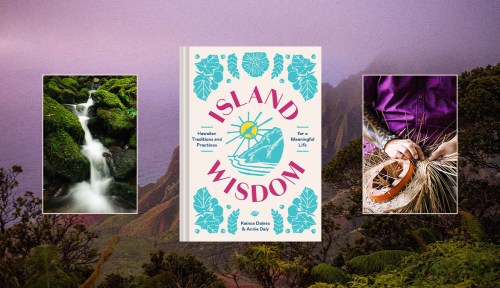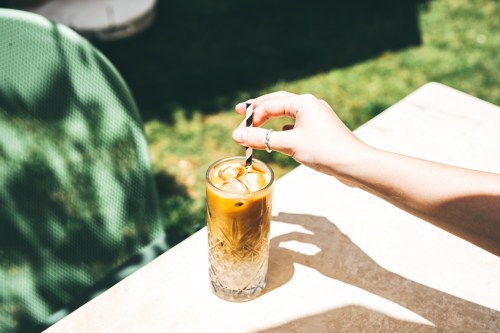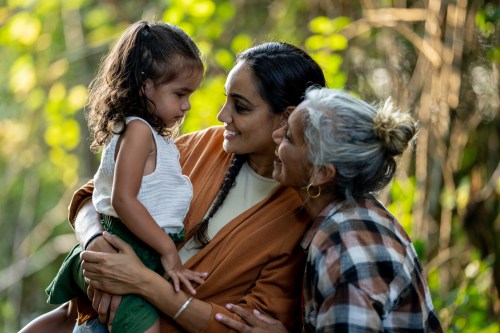Our editors independently select these products. Making a purchase through our links may earn Well+Good a commission
Hawai‘i is so much more than a beautiful paradise. While people around the globe tend to associate the islands with laid-back vacations—a time to check out from the world—the truth is that Hawaiians are incredibly tuned in to the environment around them. Hawaiians have long understood how to live in harmony with nature—and themselves.
Ancient Hawaiians sailed to the islands from the South Pacific nearly 2,000 years ago, and were able to not only survive but thrive in complete isolation. They mastered the arts of self-reliance and sustainability, developing a code of conduct, the kapu (pronounced kah-poo), that was meant to help maintain balance and order in the islands. This system of laws and regulations was mostly focused on taking care of the land that sustained them, and it is what enabled Hawaiians to prosper for so long—until the arrival of outside influences.
Once Europeans and other foreigners arrived in 1778, things started to change. The result was ultimately an unraveling of Hawaiian independence and an attempt to stamp out Hawaiian identity. But in the late 1960s and ‘70s, after decades of cultural oppression and appropriation, Hawai‘i experienced a rebirth through the Hawaiian renaissance, a resurgence of the distinctly Hawaiian cultural identity. Even so, Hawaiians continue to struggle to reclaim and maintain their identity in their homeland.
That’s a big reason why we came together to write Island Wisdom—as a call to action. Hawai‘i is currently subject to overtourism, and both locals and the land are suffering. We—Kainoa Daines, a Native Hawaiian with roots on all the major islands and an executive in Hawai‘i’s visitor industry, and Annie Daly, a New York City–based journalist with a strong love for Hawai‘i—see our book as a way to help visitors understand what the Hawaiian islands are truly about. To write it, we interviewed a trusted group of Hawaiian community leaders, activists, teachers, farmers, storytellers, elders, and more, all of whom guided us with incredible wisdom on a variety of topics.
Our hope is that by reading the book, you’ll understand how to respect the people and the culture should you visit Hawai‘i on vacation. And even if you’re not traveling to the islands anytime soon, we strongly believe that embracing Hawaiian values can help you lead a more meaningful life wherever you are.
With that in mind, read on for a brief primer on ho‘omanawanui, the Hawaiian art of patience. Perhaps learning about this traditional value will inspire you and help you find peace in your everyday life.
***
When you think of the concept of patience, you may think of sitting around and calmly waiting your turn. After all, how many times did your parents tell you to “just be patient” when you were a child waiting for something that seemed to be taking forever? But the Hawaiian art of patience—known as ho‘omanawanui—is not about passively kicking back, or waiting your turn, or even stopping at all. Rather, it’s an active pursuit of being in the moment. Broken down, ho‘o is the prefix to indicate action, manawa means time, and nui means plentiful—so ho‘omanawanui quite literally translates to “actively making big amounts of time.”
“We’re actively involved in the process of creating the time and space that is going to be required for whatever we want to happen to actually happen,” says Joe McGinn, a farmer based on O‘ahu.
This art of active patience dates back to ancient times: “Our ancestors knew that when certain fish were in season, or certain vegetables were growing, waiting for them to be ready at the right time meant the optimal result—and that philosophy has translated to modern life today,” explains Keli‘i Wilson, a Honolulu-based Hawaiian language advocate. In fact, a big part of the Hawaiian outlook on patience is the understanding that the right things will happen at the right time—inculcated with the phrase i ka manawa kupono (which translates to “at the right time”).
A big part of the Hawaiian outlook on patience is the understanding that the right things will happen at the right time—inculcated with the phrase i ka manawa kupono (which translates to “at the right time”).
“Timelines are a very Western construct,” Keoua Nelsen, a sixth-generation lauhala (pronounced lau-hah-lah) weaver in O‘ahu, points out. Instead of trying to make things happen by certain points in his life, he simply trusts that when the time is right for him to do something, he’ll know—because he won’t feel like he’s struggling. “When you’re ready intellectually, emotionally, and physically, then that will be the right time—it won’t feel like you’re going against the grain to make things happen,” he adds. “Ancient Hawaiians believed that we don’t think with our brains; we think with our guts. Our na‘au. And we always say: When things don’t feel right, step away. When things are right—when they are i ka manawa kupono—you’ll know, because things will just start flowing.”
How to practice ho‘omanawanui in your own life
Ultimately, the Hawaiian art of patience is about actively looking for the signs that your time has come—and then doing. While Westerners are often taught to chase after their dreams and make things happen for themselves, the Hawaiian way of thinking suggests observing until you see the signs and then acting.
“In the end, it doesn’t matter when in life things happen for you—it matters that they happen at the right time,” Nelson says. Here’s how to practice this philosophy wherever you are:
1. Think of ho‘omanawanui as an active art—not passive laziness
The idea of waiting for things to feel “right” may sound a bit counterintuitive or counterproductive, especially in comparison to hustle culture that encourages you to grind until you’ve achieved your goals.
But keep this in mind: Ho‘omanawanui is not about kicking back and twiddling your thumbs, waiting for life to play out before your eyes. It’s about actively creating the time and space for the right things to come into your life at the right time.
2. Consider how not being patient will impact others
“Once you realize that putting yourself first is hardly ever a good idea—especially if it may impact someone or something else in a negative way—the decision to be patient becomes much, much easier,” says Wilson, adding that you shouldn’t do this to your own detriment, but it’s nonetheless a good guiding principle for how to live your life. In that way, ho‘omanawanui goes back to the quintessentially Hawaiian idea that we’re all connected—and not everything is about a single person.
3. Practice gratitude for whatever shows up in your life, especially during times of hardship and challenge
“Hawaiians often say that life doesn’t happen to us; it happens for us,” says McGinn. “And so in that way, we try to practice gratitude for everything that enters our lives and explore the resulting fundamental question: Why are you here in my life right now? How is it that you are here to help me grow? Thinking this way helps us feel sure that we are where we are meant to be and that everything that is happening is happening at the right time—even if it’s not on the timeline we imagined for ourselves.”
Excerpted from Island Wisdom: Hawaiian Traditions and Practices for a Meaningful Life, by Kainoa Daines and Annie Daly. Published by Chronicle Prism, an imprint of Chronicle Books. Copyright © 2022 by Kainoa Daines and Annie Daly.
Sign Up for Our Daily Newsletter
Get all the latest in wellness, trends, food, fitness, beauty, and more delivered right to your inbox.
Got it, you've been added to our email list.











